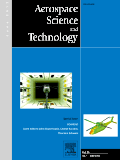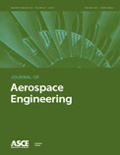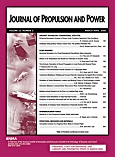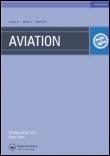
Aerospace Science and Technology
Scope & Guideline
Exploring the Frontiers of Aerospace Technology
Introduction
Aims and Scopes
- Aerodynamic Analysis and Optimization:
Research focused on improving aerodynamic performance through innovative design techniques, computational fluid dynamics, and experimental validation of aircraft components. - Control Systems and Guidance:
Development of advanced control methodologies for aerospace vehicles, including fault-tolerant systems, adaptive controllers, and guidance laws for various flight conditions. - Propulsion and Combustion Studies:
Investigations into combustion mechanisms, efficiency improvements in propulsion systems, and the effects of various fuels and combustion strategies on performance. - Structural Integrity and Material Science:
Exploration of new materials and structural designs to enhance the performance and durability of aerospace components, including analyses of impact resistance and fatigue. - Multi-disciplinary Approaches:
Integration of various engineering disciplines, such as fluid dynamics, structural engineering, and control theory, to address complex aerospace challenges. - Unmanned Aerial Systems (UAS) and Autonomous Vehicles:
Research on the design, control, and operational strategies for autonomous aerial vehicles, including UAVs and eVTOLs, focusing on safety, efficiency, and adaptability.
Trending and Emerging
- Artificial Intelligence and Machine Learning Applications:
The integration of AI and machine learning in aerodynamics, control systems, and predictive maintenance is rapidly growing, showcasing their potential to optimize performance and operational efficiency. - Sustainable Aviation Technologies:
Research focused on sustainable materials, energy-efficient propulsion systems, and environmentally friendly practices is gaining traction, driven by global efforts to reduce the carbon footprint of aviation. - Advanced Materials and Manufacturing Techniques:
Emerging interest in the development of advanced composite materials, additive manufacturing, and their applications in aerospace design is on the rise, emphasizing lightweight structures and enhanced performance. - Dynamic Flight Control Systems:
Research into dynamic and adaptive control systems that can respond to real-time changes in flight conditions is increasingly prevalent, particularly for unmanned systems and autonomous vehicles. - Hypersonic and Supersonic Flow Research:
The exploration of hypersonic and supersonic aerodynamics, including innovative designs and testing methodologies, has gained importance due to advancements in aerospace technology and the interest in high-speed travel.
Declining or Waning
- Conventional Aerodynamics:
Traditional aerodynamic studies, particularly those focusing solely on subsonic flows without considering new technologies or advanced modeling techniques, have seen reduced attention. - Static Testing Methods:
Research relying heavily on static testing methods has diminished as more dynamic and computational approaches become prevalent, allowing for more realistic simulations. - Single-Disciplinary Research:
There is a waning interest in research that does not integrate multiple disciplines, as the complexity of modern aerospace challenges necessitates multi-disciplinary collaboration. - Basic Propulsion Studies:
Research focused on conventional propulsion mechanisms without innovative advancements or hybrid systems has become less frequent, as the industry shifts towards more sustainable and efficient solutions. - Simplistic Control Techniques:
Basic control techniques that do not incorporate adaptive or intelligent systems are becoming less relevant, as the demand for sophisticated, responsive control systems increases.
Similar Journals

Aerospace Research in Bulgaria
Fostering collaboration in the aerospace community.Aerospace Research in Bulgaria is a prestigious academic journal dedicated to advancing the field of aerospace engineering and technology. Published by the BULGARIAN ACADEMY OF SCIENCES, SPACE RESEARCH & TECHNOLOGY INSTITUTE (SRTI-BAS), this journal serves as a key platform for researchers, engineers, and professionals seeking to share original research, innovative technologies, and critical reviews related to aerospace applications. With the ISSN 1313-0927 and E-ISSN 2367-9522, the journal aims to contribute significantly to the global aerospace community. Although the journal operates under a traditional access model, it emphasizes the importance of research collaboration and disseminating knowledge in the ever-evolving aerospace sector. The editorial team is committed to maintaining high standards in peer review, making it an essential resource for academics and practitioners alike. Located at ACAD. GEORGI BONCHEV STR., SOFIA 1113, BULGARIA, this journal not only highlights Bulgarian contributions to aerospace research but also aims to engage with a broader international audience, fostering advances that propel the industry forward.

JOURNAL OF AEROSPACE ENGINEERING
Elevating knowledge in aerospace through rigorous research.JOURNAL OF AEROSPACE ENGINEERING, published by the American Society of Civil Engineers (ASCE), is a premier scholarly journal that serves as an essential resource for engineers and researchers in the aerospace engineering domain. With an ISSN of 0893-1321 and an E-ISSN of 1943-5525, this journal has been dedicated to advancing knowledge since its inception in 1988 and will continue to do so through to 2024. The journal is categorized in the Q2 quartile across multiple engineering disciplines, including Aerospace Engineering, Civil and Structural Engineering, Materials Science, and Mechanical Engineering, reflecting its reputable standing in the community. The impact factor speaks to its influence and relevance, making it a critical reference for ongoing research and innovations. Although this journal does not offer open access, it ensures that its content is comprehensive, engaging, and peer-reviewed, targeting a diverse audience of professionals, academics, and students involved in the fields of aerospace engineering and related disciplines. The journal actively contributes to shaping future engineering practices, showcasing cutting-edge research and fostering collaboration among discipline experts.

JOURNAL OF PROPULSION AND POWER
Unleashing Potential in Aerospace Science and EngineeringJOURNAL OF PROPULSION AND POWER, published by the American Institute of Aeronautics and Astronautics, is a premier peer-reviewed journal dedicated to the advancement of knowledge in the fields of aerospace engineering, mechanical engineering, and fuel technology. With an impressive impact factor and ranked in the Q1 and Q2 categories for various relevant fields, the journal serves as a vital resource for researchers, professionals, and students alike who are looking to stay abreast of the latest innovations and breakthroughs in propulsion systems and power generation methodologies. Established in 1985, the journal covers a wide range of topics, ensuring a comprehensive understanding of propulsion technologies from atmospheric to space applications. Its robust Scopus rankings highlight its significance in the academic community, establishing it as a leading forum for sharing pivotal research findings and fostering collaborative dialogues that drive the aerospace industry forward. Located in Reston, Virginia, the journal does not currently offer open access options, yet it remains accessible to a vast audience via academic institutions and libraries. As we move further into the 21st century, the JOURNAL OF PROPULSION AND POWER continues to be an indispensable tool for the exploration and evolution of propulsion and power systems.

Aviation
Exploring innovative horizons in aviation research.Aviation, published by Vilnius Gediminas Technical University, is a leading open-access journal dedicated to the dynamic field of aerospace engineering, with an ISSN of 1648-7788 and E-ISSN of 1822-4180. Established in 2004 and set to converge in 2024, this journal aims to disseminate high-quality research that advances the understanding and application of aerospace technology. With an impact factor reflective of its contribution to the discipline, Aviation ranks at Q4 in the Aerospace Engineering category and occupies the 80th position out of 153 in Scopus, highlighting its growing significance among scholarly publications. By providing free access to its content since 2018, the journal enhances its reach and encourages collaborative efforts in the academic community, catering to researchers, professionals, and students eager to explore innovative studies and findings within aerospace engineering. Based in Lithuania, this journal serves as a vital resource for those aiming to contribute to the future of aviation.

AIRCRAFT ENGINEERING AND AEROSPACE TECHNOLOGY
Elevating aircraft engineering with cutting-edge insights.AIRCRAFT ENGINEERING AND AEROSPACE TECHNOLOGY, published by Emerald Group Publishing Ltd, is a leading peer-reviewed journal dedicated to advancing the fields of aerospace engineering and technology. With a strong emphasis on innovative research, the journal aims to bridge theoretical developments and practical applications within the aerospace sector. Although the journal does not currently offer open access, it continues to enrich the academic community's understanding of aircraft design, maintenance, and engineering processes, making it a crucial resource for researchers, professionals, and students alike. By fostering a rigorous dialogue among experts, AIRCRAFT ENGINEERING AND AEROSPACE TECHNOLOGY ensures the dissemination of cutting-edge findings and promotes sustainable practices in the aerospace industry, highlighted by its commitment to high-quality scholarship.

AERONAUTICAL JOURNAL
Pioneering research in aeronautical engineering.Aeronautical Journal, published by Cambridge University Press, is a premier scholarly journal dedicated to advancing the field of aerospace engineering. With a notable impact factor, this journal holds a strong position in the academic community, ranked #53 out of 153 in the Scopus category of Aerospace Engineering, placing it in the 65th percentile. The journal has been providing a platform for groundbreaking research since its inception in 1969, and continues to be a vital resource for researchers, professionals, and students involved in aeronautics. As a Q2 journal in the 2023 Aerospace Engineering category, it offers high-quality articles that cover a range of topics within the discipline, contributing to the ongoing discourse and innovation in aerospace technologies. Although not an open-access journal, it remains accessible to a vast readership through institutional subscriptions and partnerships. The Aeronautical Journal is a crucial publication for those seeking to stay at the forefront of aerospace research and development.

Journal of the Global Power and Propulsion Society
Transforming Ideas into Impactful Engineering SolutionsJournal of the Global Power and Propulsion Society, published by GLOBAL POWER PROPULSION SOC, is a premier open-access journal established in 2017, dedicated to the dissemination of innovative research and advancements in the fields of aerospace engineering, industrial and manufacturing engineering, and mechanical engineering. Based in Zug, Switzerland, this journal provides a critical platform for researchers, professionals, and students to engage with cutting-edge studies and emerging technologies that are pivotal to the aerospace and propulsion sectors. With an impressive categorization in the Q2 quartile for multiple engineering specialties in 2023, the journal reflects its commitment to quality and rigor in its peer-reviewed articles. Moreover, it holds substantial visibility in the academic community, as evidenced by its Scopus rankings. The Journal of the Global Power and Propulsion Society stands at the intersection of innovation and collaboration, aiming to foster knowledge sharing globally while enhancing the operational capabilities of power and propulsion technologies.

PROGRESS IN AEROSPACE SCIENCES
Delivering premier research for the aerospace industry.PROGRESS IN AEROSPACE SCIENCES is a prestigious journal published by PERGAMON-ELSEVIER SCIENCE LTD, recognized as a leading platform in the field of aerospace engineering, mechanical engineering, and mechanics of materials. With an impressive history dating back to 1961, the journal covers a wide spectrum of topics pivotal to advancing aerospace technology and innovation. Its recent ranking as Q1 in multiple engineering categories underscores its significance, ranking #1 in Aerospace Engineering and placing within the top 20 percentile in both Mechanical Engineering and Mechanics of Materials, according to Scopus assessments. Researchers, professionals, and students looking to engage with high-impact research will find PROGRESS IN AEROSPACE SCIENCES an invaluable resource, offering insights into cutting-edge developments and methodologies. Although it does not operate under an open-access model, the journal upholds rigorous peer-review standards, ensuring that the published content meets the highest academic integrity. Situated in the United Kingdom, it plays a critical role in fostering international collaboration and knowledge-sharing in the aerospace sector.

International Journal of Turbomachinery Propulsion and Power
Fueling research excellence in turbomachinery and power dynamics.The International Journal of Turbomachinery Propulsion and Power, published by MDPI, is a pivotal scholarly platform devoted to advancing the field of turbomachinery, propulsion technology, and power systems. Since its inception in 2016, this open-access journal has provided an invaluable resource for researchers, professionals, and students within the realms of Aerospace Engineering, Energy Engineering, and Mechanical Engineering. With its current ranking in the Q3 category across these disciplines and its strategic placement in Scopus, the journal facilitates the dissemination of cutting-edge research findings and innovative solutions. The commitment to open access, effective from 2017, ensures that high-quality research is readily accessible, fostering collaboration and knowledge sharing in the global academic community. As it continues to expand its scope through 2024, the journal remains a crucial avenue for discussion, experimentation, and advancement in turbomachinery and energy-related studies.

International Journal of Aeronautical and Space Sciences
Connecting Research and Innovation in AerospaceThe International Journal of Aeronautical and Space Sciences, published by Springer, is a prominent platform dedicated to advancing research and innovation in the fields of Aerospace Engineering, Control and Systems Engineering, Electrical and Electronic Engineering, and Materials Science. With an ISSN of 2093-274X and an E-ISSN of 2093-2480, the journal has established itself as a vital resource since its inception in 2011, currently offering insights that span a wide range of contemporary challenges and technological advancements in aeronautics and space exploration. Ranking in the Q2 category across multiple disciplines, including Aerospace and Control Engineering, signifies its recognized impact and quality within the academic community. Although not an open-access journal, it remains accessible to researchers, professionals, and students seeking to enhance their understanding of complex aerospace systems and their applications. The journal’s commitment to publishing high-quality research makes it indispensable for those aiming to contribute to, or stay informed about, the evolving landscape of aerospace technology.